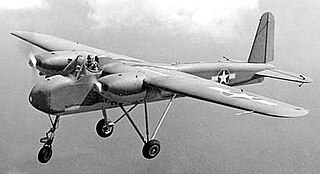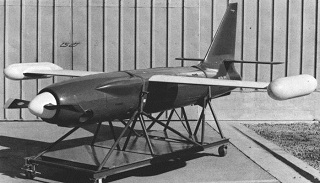
The AQM-38 was an American target drone, developed during the 1950s by the Radioplane Division of the Northrop Corporation, Newbury Park, California, and manufactured by its Ventura Division at Van Nuys, California. Extensively used for surface-to-air missile training, over two thousand were built during its production run and it saw continued use within the United States Army and United States Navy for nearly twenty years.

The OQ-2 Radioplane was the first mass-produced UAV or drone in the United States, manufactured by the Radioplane Company. A follow-on version, the OQ-3, became the most widely used target drone in US service, with over 9,400 being built during World War II.

The Radioplane BTT, known as RP-71 by the company, as WS-426/2 by the United States Navy, and as WS-462/2 by the US Air Force, is a family of target drones produced by the Radioplane Company.

The Radioplane Q-1 was an American target drone, developed in the early 1950s for the United States Air Force by the Radioplane Company. Originally powered by a pulsejet engine, then later developed as an improved turbojet-powered aircraft, the Q-1 failed to win the favor of the USAF. However, the aircraft provided the basis of the GAM-67 Crossbow anti-radar missile.

The Interstate TDR was an early unmanned combat aerial vehicle — referred to at the time as an "assault drone" — developed by the Interstate Aircraft and Engineering Corporation during the Second World War for use by the United States Navy. Capable of being armed with bombs or torpedoes, 2000 aircraft were ordered, but only around 200 were built. The type saw some service in the Pacific Theater against the Japanese, but continuing developmental issues affecting the aircraft, along with the success of operations using more conventional weapons, led to the decision being made to cancel the assault drone program in October 1944.

The Naval Aircraft Factory TDN was an early unmanned combat aerial vehicle - referred to at the time as an "assault drone" - developed by the United States Navy's Naval Aircraft Factory during the Second World War. Developed and tested during 1942 and 1943, the design proved moderately successful, but development of improved drones saw the TDN-1 relegated to second-line duties, and none were used in operational service.

The Radioplane RP-77 was a small target drone missile, constructed largely of plastic materials, produced by the Radioplane division of the Northrop Corporation. Although the RP-77D was successfully tested by the United States Army, the decision was made not to procure the aircraft.

The McDonnell TD2D Katydid was a pulsejet-powered American target drone produced by McDonnell Aircraft that entered service with the United States Navy in 1942, and continued in use until the late 1940s.
The Righter/Kiekhaefer O-45 was an air-cooled, two-stroke aircraft engine of flat-twin configuration, used extensively for powering target drones in the late 1940s.

The Radioplane XKD4R, known by the company designation RP-70, was an American target drone developed by the Radioplane Division of the Northrop Corporation. Although it was not produced in quantity, it was developed into the successful AQM-38.

The Culver XPQ-15, also known as the XTD3C-1, was an American target drone developed by the Culver Aircraft Company late in World War II.
The Frankfort OQ-16, also known as the TD3D, was a target drone designed by the Frankfort Sailplane Company for use by the United States Army Air Forces and United States Navy.
The Aerojet SD-2 Overseer was an unmanned aerial vehicle developed by Aerojet General and Rheem Manufacturing Co. in the late 1950s for use by the United States Army. Built in limited numbers, it never saw operational service.

The Radioplane Company was an American aviation company that produced drone aircraft primarily for use as gunnery targets. During World War II, they produced over 9,400 of their Radioplane OQ-3 model, a propeller-powered monoplane, making it the most-used target aircraft in the US. In the post-World War II era they introduced their Radioplane BTT series, which was produced for years and eventually reached almost 60,000 examples. They also produced several radio control and self-guided missiles, the largest being the GAM-67 Crossbow, which didn't enter service. The company was purchased by Northrop Corporation in 1952, and moved to one of Northrop's factories in 1962. One of the last projects carried out at the original Radioplane factory in Van Nuys, California, was the construction of the Gemini Paraglider.

The Naval Aircraft Modification Unit KDN Gorgon, originally designated TD2N, was an early jet-powered target drone developed by the Bureau of Aeronautics and constructed by the Naval Aircraft Modification Unit for use by the United States Navy. First flown near the end of World War II, it was cancelled due to problems with its engine in 1946.

The Republic SD-3 Snooper was an early reconnaissance drone developed by Republic Aviation for the United States Army. It was evaluated by the Army Signal Corps in 1959, but did not enter operational service.
The Naval Research Laboratory Flyrt, or Flying Radar Target, was a small electric-powered unmanned aerial vehicle developed by the United States Naval Research Laboratory to serve as an expendable radar decoy for the defense of United States Navy ships. Tested in the fall of 1993, it was considered successful but was not ordered into production.
The Radioplane OQ-6 was a target drone developed by the Radioplane Company under the designation RP-14 and evaluated by the United States Army Air Forces for service use. A small number were procured, but major production contracts were cancelled by the end of World War II.
The OQ-18 was a prototype American subscale RPV built for the US Army Air Forces in the mid-1940s.













